Operational Inundation and Water Quality Forecasting in Transitional Waters: Lessons from the Tagus Estuary, Portugal
Abstract
1. Introduction
2. Materials and Methods
2.1. Study Area
2.2. Operational Models of the Tagus Estuary
2.2.1. The Tagus Forecast System
2.2.2. Numerical Models Setup
2D Barotropic Model with Wave–Current Interactions for Inundation Prediction
3D Baroclinic Model
2.3. Operational Models Assessment
3. Results and Discussion
3.1. The 2D Barotropic Operational Model
3.1.1. Water Levels Forecasts
3.1.2. Wave Forecasts
3.2. The 3D Baroclinic Model
3.2.1. Water Levels Forecasts
3.2.2. Salinity and Water Temperature Forecasts
3.2.3. Water Quality Forecasts
3.3. Operational Inundation and Water Quality Forecasts as Effective Services to Support Coastal Management
4. Conclusions
Supplementary Materials
Author Contributions
Funding
Data Availability Statement
Acknowledgments
Conflicts of Interest
References
- Barbier, E.B.; Hacker, S.D.; Kennedy, C.; Koch, E.W.; Stier, A.C.; Silliman, B.R. The value of estuarine and coastal ecosystem services. Ecol. Monogr. 2011, 81, 169–193. [Google Scholar] [CrossRef]
- Boerema, A.; Meire, P. Management for estuarine ecosystem services: A review. Ecol. Eng. 2017, 98, 172–182. [Google Scholar] [CrossRef]
- Booi, S.; Mishi, S.; Andersen, O. Ecosystem services: A systematic review of provisioning and cultural ecosystem services in estuaries. Sustainability 2022, 14, 7252. [Google Scholar] [CrossRef]
- Donázar-Aramendía, I.; Sánchez-Moyano, J.E.; García-Asencio, I.; Florido, M.; Pascual-Fernández, N.; García-Gasco, L. Human pressures on two estuaries of the Iberian Peninsula are reflected in food web structure. Sci. Rep. 2019, 9, 11495. [Google Scholar] [CrossRef] [PubMed]
- Andersen, J.H.; Al-Hamdani, Z.; Harvey, E.T.; Kallenbach, E.; Murray, C.; Stock, A. Relative impacts of multiple human stressors in estuaries and coastal waters in the North Sea–Baltic Sea transition zone. Sci. Total Environ. 2020, 704, 135316. [Google Scholar] [CrossRef]
- De Dominicis, M.; Wolf, J.; Jevrejeva, S.; Zheng, P. Future interactions between sea level rise, tides, and storm surges in the world’s largest urban area. Geophys. Res. Lett. 2020, 47, e2020GL087002. [Google Scholar] [CrossRef]
- Kennish, M.J. Drivers of change in estuarine and coastal marine environments: An overview. Open J. Ecol. 2021, 11, 266–289. [Google Scholar] [CrossRef]
- Priya, A.K.; Muruganandam, M.; Rajamanickam, S.; Sivarethinamohan, S.; Gaddam, M.K.R.; Velusamy, P.; Gomathi, R.; Ravindiran, G.; Gurugubelli, T.R.; Muniasamy, S.K. Impact of climate change and anthropogenic activities on aquatic ecosystem—A review. Environ. Res. 2023, 238 Pt 2, 117233. [Google Scholar] [CrossRef]
- Elliott, M.; Whitfield, A.K. Challenging paradigms in estuarine ecology and management. Estuar. Coast. Shelf Sci. 2011, 94, 306–314. [Google Scholar] [CrossRef]
- Rocha, C.; Galvão, H.; Barbosa, A. Role of transient silicon limitation in the development of cyanobacteria blooms in the Guadiana estuary, south-western Iberia. Mar. Ecol. Prog. Ser. 2002, 228, 35–45. [Google Scholar] [CrossRef]
- Kerner, M. Effects of deepening the Elbe Estuary on sediment regime and water quality. Estuar. Coast. Shelf Sci. 2007, 75, 492–500. [Google Scholar] [CrossRef]
- Rothenberger, M.B.; Burkholder, J.M.; Brownie, C. Long-term effects of changing land use practices on surface water quality in a coastal river and lagoonal estuary. Environ. Manag. 2009, 44, 505–523. [Google Scholar] [CrossRef] [PubMed]
- Wetz, M.S.; Yoskowitz, D.W. An ‘extreme’ future for estuaries? Effects of extreme climatic events on estuarine water quality and ecology. Mar. Pollut. Bull. 2013, 69, 7–18. [Google Scholar] [CrossRef] [PubMed]
- Freeman, L.A.; Corbett, D.R.; Fitzgerald, A.M.; Lemley, D.A.; Quigg, A.; Steppe, C.N. Impacts of urbanization and development on estuarine ecosystems and water quality. Estuaries Coasts 2019, 42, 1821–1838. [Google Scholar] [CrossRef]
- Mayo, T.L.; Lin, N. Climate change impacts to the coastal flood hazard in the northeastern United States. Weather. Clim. Extrem. 2022, 36, 100453. [Google Scholar] [CrossRef]
- Green, J.; Haigh, I.D.; Quinn, N.; Neal, J.; Wahl, T.; Wood, M.; Eilander, D.; de Ruiter, M.; Ward, P.; Camus, P. Review article: A comprehensive review of compound flooding literature with a focus on coastal and estuarine regions. Nat. Hazards Earth Syst. Sci. 2025, 25, 747–816. [Google Scholar] [CrossRef]
- Jang, J.-H.; Chang, T.-H.; Wu, Y.-M.; Liao, T.-E.; Hsu, C.-H. Analyzing the impact of climate change on compound flooding under interdecadal variations in rainfall and tide. Hydrology 2025, 12, 182. [Google Scholar] [CrossRef]
- Pareja-Roman, L.F.; Orton, P.M.; Talke, S.A. Effect of estuary urbanization on tidal dynamics and high tide flooding in a coastal lagoon. J. Geophys. Res. Ocean. 2023, 128, e2022JC018777. [Google Scholar] [CrossRef]
- Fennel, K.; Gehlen, M.; Brasseur, P.; Brown, C.W.; Ciavatta, S.; Cossarini, G.; Crise, A.; Edwards, C.A.; Ford, D.; Friedrichs, M.A.M.; et al. Advancing marine biogeochemical and ecosystem reanalyses and forecasts as tools for monitoring and managing ecosystem health. Front. Mar. Sci. 2019, 6, 89. [Google Scholar] [CrossRef]
- Cirano, M.; Alvarez-Fanjul, E.; Capet, A.; Ciliberti, S.; Clementi, E.; Dewitte, B.; Dinápoli, M.; El Serafy, G.; Hogan, P.; Joseph, S.; et al. A description of existing operational ocean forecasting services around the globe. In Ocean Prediction: Present Status and State of the Art (OPSR) (State of the Planet); Álvarez Fanjul, E., Ciliberti, S.A., Pearlman, J., Wilmer-Becker, K., Behera, S., Eds.; Copernicus Publications: Göttingen, Germany, 2025; Volume 5-opsr, p. 5. [Google Scholar] [CrossRef]
- Fortunato, A.B.; Oliveira, A.; Rogeiro, J.; Tavares da Costa, R.; Gomes, J.L.; Li, K.; Jesus, G.; Freire, P.; Rilo, A.; Mendes, A.; et al. Operational forecast framework applied to extreme sea levels at regional and local scales. J. Oper. Oceanogr. 2017, 10, 1–15. [Google Scholar] [CrossRef]
- Sotillo, M.G.; Cerralbo, P.; Lorente, P.; Grifoll, M.; Espino, M.; Sanchez-Arcilla, A.; Alvarez-Fanjul, E. Coastal ocean forecasting in Spanish ports: The Samoa operational service. J. Oper. Oceanogr. 2019, 13, 37–54. [Google Scholar] [CrossRef]
- García-León, M.; Sotillo, M.G.; Mestres, M.; Espino, M.; Álvarez-Fanjul, E. Improving operational ocean models for the Spanish Port Authorities: Assessment of the SAMOA coastal forecasting service upgrades. J. Mar. Sci. Eng. 2022, 10, 149. [Google Scholar] [CrossRef]
- Juza, M.; Mourre, B.; Renault, L.; Gómara, S.; Sebastián, K.; Lora, S.; Beltran, J.P.; Frontera, B.; Garau, B.; Troupin, C.; et al. SOCIB operational ocean forecasting system and multi-platform validation in the Western Mediterranean Sea. J. Oper. Oceanogr. 2016, 9, 155–166. [Google Scholar] [CrossRef]
- Mourre, B.; Aguiar, E.; Juza, M.; Hernandez-Lasheras, J.; Reyes, E.; Heslop, E.; Escudier, R.; Cutolo, E.; Ruiz, S.; Mason, E.; et al. Assessment of high-resolution regional ocean prediction systems using multi-platform observations: Illustrations in the Western Mediterranean Sea. In New Frontiers in Operational Oceanography; Chassignet, E., Pascual, A., Tintoré, J., Verron, J., Eds.; GODAE OceanView, 2018; pp. 663–694. [Google Scholar] [CrossRef]
- Schiller, A.; Brassington, G.B.; Oke, P.; Cahill, M.; Divakaran, P.; Entel, M.; Freeman, J.; Griffin, D.; Herzfeld, M.; Hoeke, R.; et al. Bluelink ocean forecasting Australia: 15 years of operational ocean service delivery with societal, economic and environmental benefits. J. Oper. Oceanogr. 2020, 13, 1–18. [Google Scholar] [CrossRef]
- Chondros, M.; Metallinos, A.; Papadimitriou, A.; Memos, C.; Tsoukala, V. A coastal flood early-warning system based on offshore sea state forecasts and artificial neural networks. J. Mar. Sci. Eng. 2021, 9, 1272. [Google Scholar] [CrossRef]
- Gan, M.; Chen, Y.; Pan, S.; Lai, X.; Pan, H.; Wen, Y.; Xia, M. An improved machine learning-based model to predict estuarine water levels. Ocean Model. 2024, 190, 102376. [Google Scholar] [CrossRef]
- Davidson, F.; Alvera-Azcárate, A.; Barth, A.; Brassington, G.B.; Chassignet, E.P.; Clementi, E.; De Mey-Frémaux, P.; Divakaran, P.; Harris, C.; Hernandez, F.; et al. Synergies in operational oceanography: The intrinsic need for sustained ocean observations. Front. Mar. Sci. 2019, 6, 450. [Google Scholar] [CrossRef]
- Alvarez Fanjul, E.; Ciliberti, S.; Pearlman, J.; Wilmer-Becker, K.; Bahurel, P.; Ardhuin, F.; Arnaud, A.; Azizzadenesheli, K.; Aznar, R.; Bell, M.; et al. Promoting best practices in ocean forecasting through an Operational Readiness Level. Front. Mar. Sci. 2024, 11, 1443284. [Google Scholar] [CrossRef]
- Rodrigues, M.; Martins, R.; Rogeiro, J.; Fortunato, A.B.; Oliveira, A.; Cravo, A.; Jacob, J.; Rosa, A.; Azevedo, A.; Freire, P. A web-based observatory for biogeochemical assessment in coastal regions. J. Environ. Inform. 2021, 38, 1–15. [Google Scholar] [CrossRef]
- Martin, M.J.; Balmaseda, M.; Bertino, L.; Brasseur, P.; Brassington, G.; Cummings, J.; Weaver, A.T. Status and future of data assimilation in operational oceanography. J. Oper. Oceanogr. 2015, 8 (Suppl. S1), s28–s48. [Google Scholar] [CrossRef]
- Martin, M.J.; Hoteit, I.; Bertino, L.; Moore, A.M. Data assimilation schemes for ocean forecasting: State of the art. In Ocean Prediction: Present Status and State of the Art (OPSR) (State of the Planet); Álvarez Fanjul, E., Ciliberti, S.A., Pearlman, J., Wilmer-Becker, K., Behera, S., Eds.; Copernicus Publications: Göttingen, Germany, 2025; Volume 5-opsr, p. 9. [Google Scholar] [CrossRef]
- Oliveira, A.; Fortunato, A.B.; Rogeiro, J.; Teixeira, J.; Azevedo, A.; Lavaud, L.; Bertin, A.; Gomes, J.; David, M.; Pina, J.; et al. OPENCoastS: An open-access service for the automatic generation of coastal forecast systems. Environ. Model. Softw. 2020, 124, 104585. [Google Scholar] [CrossRef]
- Oliveira, A.; Fortunato, A.B.; Rodrigues, M.; Azevedo, A.; Rogeiro, J.; Bernardo, S.; Lavaud, B.; Bertin, X.; Nahon, A.; Jesus, G.; et al. Forecasting contrasting coastal and estuarine hydrodynamics with OPENCoastS. Environ. Model. Softw. 2021, 143, 105132. [Google Scholar] [CrossRef]
- Trotta, F.; Federico, I.; Pinardi, N.; Coppini, G.; Causio, S.; Jansen, E.; Iovino, D.; Masina, S. A relocatable ocean modeling platform for downscaling to shelf-coastal areas to support disaster risk reduction. Front. Mar. Sci. 2021, 8, 642815. [Google Scholar] [CrossRef]
- Sotillo, M.G.; Cailleau, S.; Lorente, P.; Levier, B.; Reffray, G.; Amo-Baladrón, A.; Benkiran, M.; Alvarez Fanjul, E. The MyOcean IBI ocean forecast and reanalysis systems: Operational products and roadmap to the future Copernicus service. J. Oper. Oceanogr. 2015, 8, 63–79. [Google Scholar] [CrossRef]
- Sotillo, M.G.; Campuzano, F.; Guihou, K.; Lorente, P.; Olmedo, E.; Matulka, A.; Santos, F.; Amo-Baladrón, M.A.; Novellino, A. River freshwater contribution in operational ocean models along the European Atlantic façade: Impact of a new river discharge forcing data on the CMEMS IBI regional model solution. J. Mar. Sci. Eng. 2021, 9, 401. [Google Scholar] [CrossRef]
- Aznar, R.; Sotillo, M.G.; Cailleau, S.; Lorente, P.; Levier, B.; Amo-Baladrón, A.; Reffray, G.; Alvarez Fanjul, E. Strengths and weaknesses of the CMEMS forecasted and reanalyzed solutions for the Iberia-Biscay-Ireland (IBI) waters. J. Mar. Syst. 2016, 159, 1–14. [Google Scholar] [CrossRef]
- Lorente, P.; García-Sotillo, M.; Amo-Baladrón, A.; Aznar, R.; Levier, B.; Sánchez-Garrido, J.C.; Sammartino, S.; de Pascual-Collar, Á.; Reffray, G.; Toledano, C.; et al. Skill assessment of global, regional, and coastal circulation forecast models: Evaluating the benefits of dynamical downscaling in IBI (Iberia-Biscay-Ireland) surface waters. Ocean Sci. 2019, 15, 967–996. [Google Scholar] [CrossRef]
- Mason, E.; Ruiz, S.; Bourdalle-Badie, R.; Reffray, G.; García-Sotillo, M.; Pascual, A. New insight into 3-D mesoscale eddy properties from CMEMS operational models in the western Mediterranean. Ocean Sci. 2019, 15, 1111–1131. [Google Scholar] [CrossRef]
- Toledano, C.; Ghantous, M.; Lorente, P.; Dalphinet, A.; Aouf, L.; Sotillo, M.G. Impacts of an altimetric wave data assimilation scheme and currents-wave coupling in an operational wave system: The new Copernicus Marine IBI wave forecast service. J. Mar. Sci. Eng. 2022, 10, 457. [Google Scholar] [CrossRef]
- Gutknecht, E.; Reffray, G.; Mignot, A.; Dabrowski, T.; Sotillo, M.G. Modelling the marine ecosystem of Iberia-Biscay-Ireland (IBI) European waters for CMEMS operational applications. Ocean Sci. 2019, 15, 1489–1516. [Google Scholar] [CrossRef]
- Vaz, N.; Mateus, M.; Pinto, L.; Neves, R.; Dias, J.M. The Tagus Estuary as a numerical modeling test bed: A review. Geosciences 2020, 10, 4. [Google Scholar] [CrossRef]
- Vieira, J.R. Contribuição para o Estudo de Processos de Circulação em Regiões Costeiras: Desenvolvimento e Aplicação dum Modelo Matemático por Elementos Finitos. Ph.D. Thesis, Instituto Superior Técnico, Lisbon, Portugal, 1991. [Google Scholar]
- Fortunato, A.B.; Baptista, A.M.; Luettich, R.A., Jr. A three-dimensional model of tidal currents in the mouth of the Tagus Estuary. Cont. Shelf Res. 1997, 17, 1689–1714. [Google Scholar] [CrossRef]
- Portela, L.I. Modelação Matemática de Processos Hidrodinâmicos e de Qualidade da Água no Estuário do Tejo. Ph.D. Thesis, Instituto Superior Técnico, Universidade Técnica de Lisboa, Lisbon, Portugal, 1996. [Google Scholar]
- Barros, A.P.; Baptista, A.M. An Eulerian-Lagrangian model for sediment transport in estuaries. In Estuarine and Coastal Modeling; Spalding, M., Ed.; American Society of Civil Engineers: Reston, VA, USA, 1990; pp. 102–112. [Google Scholar]
- Portela, L.I.; Neves, R. Numerical modelling of suspended sediment transport in tidal estuaries: A comparison between the Tagus (Portugal) and the Scheldt (Belgium–The Netherlands). Neth. J. Aquat. Ecol. 1994, 28, 329–335. [Google Scholar] [CrossRef]
- Barros, A.P. An evaluation of model parameterizations of sediment pathways: A case study for the Tagus Estuary. Cont. Shelf Res. 1996, 16, 1725–1749. [Google Scholar] [CrossRef]
- Oliveira, A.; Baptista, A.M. Diagnostic modeling of residence times in estuaries. Water Resour. Res. 1997, 33, 1935–1946. [Google Scholar] [CrossRef]
- Fortunato, A.B.; Oliveira, A.; Baptista, A.M. On the effect of tidal flats on the hydrodynamics of the Tagus estuary. Oceanol. Acta 1999, 22, 31–44. [Google Scholar] [CrossRef]
- Vaz, N.; Fernandes, L.; Leitão, P.C.; Dias, J.M.; Neves, R.; Manuel, A. The Tagus estuarine plume induced by wind and river runoff: Winter 2007 case study. J. Coast. Res. 2009, 56, 1090–1094. [Google Scholar]
- Saraiva, S. Produção Primária de Biomassa no Estuário do Tejo. Master’s Thesis, Instituto Superior Técnico, Universidade Técnica de Lisboa, Lisbon, Portugal, 2001. [Google Scholar]
- Saraiva, S.; Pina, P.; Martins, F.; Santos, M.; Braunschweig, F.; Neves, R. Modelling the influence of nutrient loads on Portuguese estuaries. Hydrobiologia 2007, 587, 5–18. [Google Scholar] [CrossRef]
- Mateus, M.; Neves, R. Evaluating light and nutrient limitation in the Tagus estuary using a process-oriented ecological model. J. Mar. Eng. Technol. 2008, 7, 43–54. [Google Scholar] [CrossRef]
- Braunschweig, F.; Leitão, P.C.; Fernandes, L.; Pina, P.; Neves, R.J.J. The object-oriented design of the integrated water modelling system MOHID. Dev. Water Sci. 2004, 55, 1079–1090. [Google Scholar] [CrossRef]
- Rusu, L.; Bernardino, M.; Guedes Soares, C. Modelling the influence of currents on wave propagation at the entrance of the Tagus estuary. Ocean Eng. 2011, 38, 1174–1183. [Google Scholar] [CrossRef]
- Fortunato, A.B.; Freire, P.; Bertin, X.; Rodrigues, M.; Ferreira, J.; Liberato, M.L.R. A numerical study of the February 15, 1941 storm in the Tagus estuary. Cont. Shelf Res. 2017, 144, 50–64. [Google Scholar] [CrossRef]
- Valentim, J.M.; Vaz, N.; Silva, H.; Duarte, B.; Caçador, I.; Dias, J.M. Tagus estuary and Ria de Aveiro saltmarsh dynamics and the impact of sea level rise. Estuar. Coast. Shelf Sci. 2013, 130, 138–151. [Google Scholar] [CrossRef]
- Guerreiro, M.; Fortunato, A.B.; Freire, P.; Rilo, A.; Taborda, R.; Freitas, M.C.; Andrade, C.; Silva, T.; Rodrigues, M.; Bertin, X.; et al. Evolution of the hydrodynamics of the Tagus estuary (Portugal) in the 21st century. Rev. Gestão Costeira Integr./J. Integr. Coast. Zone Manag. 2015, 15, 65–80. [Google Scholar] [CrossRef]
- Rodrigues, M.; Fortunato, A.B. Assessment of a three-dimensional baroclinic circulation model of the Tagus estuary. AIMS Environ. Sci. 2017, 4, 763–787. [Google Scholar] [CrossRef]
- Rodrigues, M.; Fortunato, A.B.; Freire, P. Saltwater intrusion in the upper Tagus estuary during droughts. Geosciences 2019, 9, 400. [Google Scholar] [CrossRef]
- Oliveira, A.; Rogeiro, J.; Jesus, G.; Fortunato, A.B.; David, L.M.; Rodrigues, M.; Costa, J.; Mota, T.; Gomes, J.L.; Matos, R. Real-time monitoring and forecast platform to support early warning of faecal contamination in recreational waters. In Climate Change, Water Supply and Sanitation: Risk Assessment, Management, Mitigation and Reduction; Hulsmann, A., Grützmacher, G., van den Berg, G., Rauch, W., Jensen, A.L., Popovych, V., Mazzola, M.R., Vamvakeridou-Lyroudia, L.S., Savić, D.A., Eds.; IWA Publishing: London, UK, 2015; Chapter 3.13; pp. 102–112. ISBN 9781780404998. [Google Scholar]
- Póvoa, P.; Nobre, A.; Leitão, P.; Galvão, P.; Santos, H.; Frazão, A.; Neves, R.; Matos, J.S. Operational decision support system for large combined sewage systems: Lisbon/Tagus estuary case study. Water Sci. Technol. 2015, 72, 1421–1427. [Google Scholar] [CrossRef][Green Version]
- Franz, G.; Fernandes, R.; De Pablo, H.; Viegas, C.; Pinto, L.; Campuzano, F.; Ascione, I.; Leitão, P.; Neves, R. Tagus estuary hydro-biogeochemical model: Inter-annual validation and operational model update. In 3as Jornadas de Engenharia Hidrográfica; Instituto Hidrográfico: Lisbon, Portugal, 2014; pp. 103–106. [Google Scholar]
- Rilo, A.; Tavares, A.; Freire, P.; Pinto Santos, P.; Zêzere, J.L. The contribution of historical information to flood risk management in the Tagus estuary. Int. J. Disaster Risk Reduct. 2017, 25, 22–35. [Google Scholar] [CrossRef]
- Ferreira, J.G.; Simas, T.; Nobre, A.; Silva, M.C.; Schifferegger, K.; Lencart-Silva, J. Identification of Sensitive Areas and Vulnerable Zones in Transitional and Coastal Portuguese Systems: Application of the United States National Estuarine Eutrophication Assessment to the Minho, Lima, Douro, Ria de Aveiro, Mondego, Tagus, Sado, Mira, Ria Formosa and Guadiana Systems; INAG/IMAR: Lisbon, Portugal, 2003. [Google Scholar]
- Brogueira, M.J.; Cabeçadas, G. Identification of similar environmental areas in Tagus estuary by using multivariate analysis. Ecol. Indic. 2006, 6, 508–515. [Google Scholar] [CrossRef]
- Brito, A.C.; Moita, T.; Gameiro, C.; Silva, T.; Anselmo, T.; Brotas, V. Changes in the phytoplankton composition in a temperate estuarine system (1960 to 2010). Estuaries Coasts 2015, 38, 1678–1691. [Google Scholar] [CrossRef]
- Caetano, M.; Raimundo, J.; Nogueira, M.; Santos, M.; Mil-Homens, M.; Prego, R.; Vale, C. Defining benchmark values for nutrients under the Water Framework Directive: Application in twelve Portuguese estuaries. Mar. Chem. 2016, 185, 27–37. [Google Scholar] [CrossRef]
- Rodrigues, M.; Cravo, A.; Freire, P.; Rosa, A.; Santos, D. Temporal assessment of the water quality along an urban estuary (Tagus estuary, Portugal). Mar. Chem. 2020, 223, 103824. [Google Scholar] [CrossRef]
- Borges, C.; Bettencourt da Silva, R.J.N.; Palma, C. Determination of river water composition trends with uncertainty: Seasonal variation of nutrients concentration in Tagus river estuary in the dry 2017 year. Mar. Pollut. Bull. 2020, 158, 111371. [Google Scholar] [CrossRef]
- de Freitas, J.G.; Dias, J.A. 1941 windstorm effects on the Portuguese Coast: What lessons for the future? J. Coast. Res. 2013, 65 (Suppl. S1), 714–719. [Google Scholar] [CrossRef]
- Castanheiro, J.M. Distribution, transport and sedimentation of suspended matter in the Tejo Estuary. In Estuarine Processes: An Application to the Tagus Estuary; Secretaria de Estado do Ambiente e Recursos Naturais: Lisboa, Portugal, 1986; pp. 75–90. [Google Scholar]
- Agência Portuguesa do Ambiente, APA. Plano de Gestão da Região Hidrográfica do Tejo, Relatório Técnico—Síntese; Ministério da Agricultura, do Mar, do Ambiente e do Ordenamento do Território: Lisbon, Portugal, 2012; p. 294. [Google Scholar]
- Neves, F.S. Dynamics and Hydrology of the Tagus Estuary: Results from In Situ Observations. Ph.D. Thesis, Universidade de Lisboa, Lisbon, Portugal, 2010. [Google Scholar]
- Zhang, Y.J.; Ye, F.; Stanev, E.V.; Grashorn, S. Seamless cross-scale modeling with SCHISM. Ocean Model. 2016, 102, 64–81. [Google Scholar] [CrossRef]
- Roland, A.; Zhang, Y.J.; Wang, H.V.; Meng, Y.; Teng, Y.-C.; Maderich, V.; Brovchenko, I.; Dutour-Sikiric, M.; Zanke, U. A fully coupled 3D wave-current interaction model on unstructured grids. J. Geophys. Res. Ocean. 2012, 117, C00J33. [Google Scholar] [CrossRef]
- Rodrigues, M.; Oliveira, A.; Queiroga, H.; Fortunato, A.B.; Zhang, Y.J. Three-dimensional modeling of the lower trophic levels in the Ria de Aveiro (Portugal). Ecol. Model. 2009, 220, 1274–1290. [Google Scholar] [CrossRef]
- Rodrigues, M.; Oliveira, A.; Queiroga, H.; Brotas, V. Seasonal and diurnal water quality modelling along a salinity gradient (Mira channel, Aveiro lagoon, Portugal). Procedia Environ. Sci. 2012, 13, 899–918. [Google Scholar] [CrossRef]
- Bisset, W.P.; Debra, S.; Dye, D. Ecological Simulation (EcoSim) 2.0: Technical Description; Florida Environmental Research Institute: Tampa, FL, USA, 2004. [Google Scholar]
- Vichi, M.; Pinardi, N.; Masina, S. A generalized model of pelagic biogeochemistry for the global ocean ecosystem. Part I: Theory. J. Mar. Syst. 2007, 64, 89–109. [Google Scholar] [CrossRef]
- Fortunato, A.B.; Freire, P.; Mengual, B.; Bertin, X.; Pinto, C.; Martins, K.; Guérin, T.; Azevedo, A. Sediment dynamics and morphological evolution in the Tagus Estuary inlet. Mar. Geol. 2021, 440, 106590. [Google Scholar] [CrossRef]
- Fortunato, A.B.; Freire, P.; Ana, R.; Viseu, T.; Rodrigues, M. Mapping inundation of estuarine margins driven by ocean and fluvial forcings. In Proceedings of the 8th IAHR Congress, Lisbon, Portugal, 4–7 June 2024; pp. 229–235. [Google Scholar] [CrossRef]
- Castellanos, P.; Brito, A.C.; Chainho, P.; Quintella, B.; da Costa, L.; França, S.; Cabral, H.; Costa, J.L. CoastNet dataset from Mondego, Tejo and Mira estuaries: Multiparametric measurements during 2020. Front. Mar. Sci. 2021, 8, 707089. [Google Scholar] [CrossRef]
- França, S.; Fonseca, V.F.; Tanner, S.E.; Vasconcelos, R.; Reis-Santos, P.; Maia, A.; Ruano, M.; Cardoso, I.; Henriques, S.; Pais, M.P.; et al. Historical data in the CoastNet Geoportal: Snapshot of estuarine fish communities in Portuguese estuaries. Front. Mar. Sci. 2021, 8, 685294. [Google Scholar] [CrossRef]
- Brandão, P.; da Costa, L.M.; Costa, J.L.; Cabral, H.N.; Marques, T.A.; França, S. Trends in fish diversity in Portuguese estuaries in the past decades and predictions in face of global changes. Estuar. Coast. Shelf Sci. 2025, 312, 109048. [Google Scholar] [CrossRef]
- Stark, J.D.; Donlon, C.J.; Martin, M.J.; McCulloch, M.E. OSTIA: An operational, high resolution, real time, global sea surface temperature analysis system. In Proceedings of the OCEANS 07 IEEE, Aberdeen, UK, 18–21 June 2007. [Google Scholar] [CrossRef]
- Donlon, C.J.; Martin, M.; Stark, J.; Roberts-Jones, J.; Fiedler, E.; Wimmer, W. The Operational Sea Surface Temperature and Sea Ice Analysis (OSTIA) system. Remote Sens. Environ. 2012, 116, 140–158. [Google Scholar] [CrossRef]
- Good, S.; Fiedler, E.; Mao, C.; Martin, M.J.; Maycock, A.; Reid, R.; Roberts-Jones, J.; Searle, T.; Waters, J.; While, J.; et al. The current configuration of the OSTIA system for operational production of foundation sea surface temperature and ice concentration analyses. Remote Sens. 2020, 12, 720. [Google Scholar] [CrossRef]
- Rodrigues, M.; Rogeiro, J.; David, L.; Fortunato, A.B.; Oliveira, A. Análise de sensibilidade à incerteza dos forçamentos na previsão da qualidade da água em tempo real. In Proceedings of the Atas do 13° Congresso da Água, Lisbon, Portugal, 7–9 March 2016; 15p. [Google Scholar]
- Gameiro, C.; Zwolinski, J.; Brotas, V. Light control on phytoplankton production in a shallow and turbid estuarine system. Hydrobiologia 2011, 669, 249–263. [Google Scholar] [CrossRef]
- Vale, C.; Sundby, B. Suspended sediment fluctuations in the Tagus Estuary on semi-diurnal and fortnightly time scales. Estuar. Coast. Shelf Sci. 1987, 25, 495–508. [Google Scholar] [CrossRef]
- Franz, G.; Pinto, L.; Ascione Kenov, I.; Mateus, M.; Fernandes, R.; Leitão, P.; Neves, R. Modelling of cohesive sediment dynamics in tidal estuarine systems: Case study of Tagus estuary, Portugal. Estuar. Coast. Shelf Sci. 2014, 151, 34–44. [Google Scholar] [CrossRef]
- De Jonge, V.N.; Van Beuselom, J.E.E. Contribution of resuspended microphytobenthos to total phytoplankton in the EMS estuary and its possible role for grazers. Neth. J. Sea Res. 1992, 30, 91–105. [Google Scholar] [CrossRef]
- Brito, A.C.; Fernandes, T.F.; Newton, A.; Facca, C.; Tett, P. Does microphytobenthos resuspension influence phytoplankton in shallow systems? A comparison through a Fourier series analysis. Estuar. Coast. Shelf Sci. 2012, 110, 77–84. [Google Scholar] [CrossRef]
- Brito, A.C.; Benyoucef, I.; Jesus, B.; Brotas, V.; Gernez, P.; Mendes, C.R.; Launeau, P.; Peixe Dias, M.; Barillé, L. Seasonality of microphytobenthos revealed by remote-sensing in a South European estuary. Cont. Shelf Res. 2013, 66, 83–91. [Google Scholar] [CrossRef]
- Gameiro, C.; Brotas, V. Patterns of phytoplankton variability in the Tagus Estuary. Estuaries Coasts 2010, 33, 311–323. [Google Scholar] [CrossRef]
- Cereja, R.; Chainho, P.; Brotas, V.; Cruz, J.P.C.; Sent, G.; Rodrigues, M.; Carvalho, F.; Cabral, S.; Brito, A.C. Spatial variability of physicochemical parameters and phytoplankton at the Tagus Estuary (Portugal). Sustainability 2022, 14, 13342. [Google Scholar] [CrossRef]
- Staneva, J.; Melet, A.; Veitch, J.; Matte, P. Solving coastal dynamics: Introduction to high-resolution ocean forecasting services. In Ocean Prediction: Present Status and State of the Art (OPSR); Álvarez Fanjul, E., Ciliberti, S.A., Pearlman, J., Wilmer-Becker, K., Behera, S., Eds.; Copernicus Publications: Göttingen, Germany, 2025; Volume 5-opsr, p. 4. [Google Scholar] [CrossRef]
- Zhang, Y.J.; Anderson, J.; Park, K.; Wu, C.H.; Wipperfurth, S.; Anderson, E.; Pe’eri, S.; Beletsky, D.; Titze, D.; Di Lorenzo, E.; et al. Debunking common myths in coastal circulation modeling. Ocean Model. 2024, 190, 102401. [Google Scholar] [CrossRef]
- Jesus, G.; Mardani, Z.; Alves, E.; Oliveira, A. Deep learning-based river flow forecasting with MLPs: Comparative exploratory analysis applied to the Tejo and the Mondego rivers. Sensors 2025, 25, 2154. [Google Scholar] [CrossRef]
- Song, H.; Edwards, C.A.; Moore, A.M.; Fiechter, J. Data assimilation in a coupled physical-biogeochemical model of the California current system using an incremental lognormal 4-dimensional variational approach: Part 3—Assimilation in a realistic context using satellite and in situ observations. Ocean Model. 2016, 106, 159–172. [Google Scholar] [CrossRef]
- Moore, A.M.; Martin, M.J.; Akella, S.; Arango, H.G.; Balmaseda, M.; Bertino, L.; Ciavatta, S.; Cornuelle, B.; Cummings, J.; Frolov, S.; et al. Synthesis of ocean observations using data assimilation for operational, real-time and reanalysis systems: A more complete picture of the state of the ocean. Front. Mar. Sci. 2019, 6, 90. [Google Scholar] [CrossRef]
- Zhang, H.; Shen, D.; Bao, S.; Len, P. Two-way coupling of the National Water Model (NWM) and semi-implicit cross-scale Hydroscience Integrated System Model (SCHISM) for enhanced coastal discharge predictions. Hydrology 2024, 11, 145. [Google Scholar] [CrossRef]
- Feng, D.; Tan, Z.; Engwirda, D.; Wolfe, J.D.; Xu, D.; Liao, C.; Bisht, G.; Benedict, J.J.; Zhou, T.; Li, H.-Y.; et al. Simulation of compound flooding using river-ocean two-way coupled E3SM ensemble on variable-resolution meshes. J. Adv. Model. Earth Syst. 2024, 16, e2023MS004054. [Google Scholar] [CrossRef]
- Sobrinho, J.; de Pablo, H.; Campuzano, F.; Neves, R. Coupling Rivers and Estuaries with an Ocean Model: An Improved Methodology. Water 2021, 13, 2284. [Google Scholar] [CrossRef]
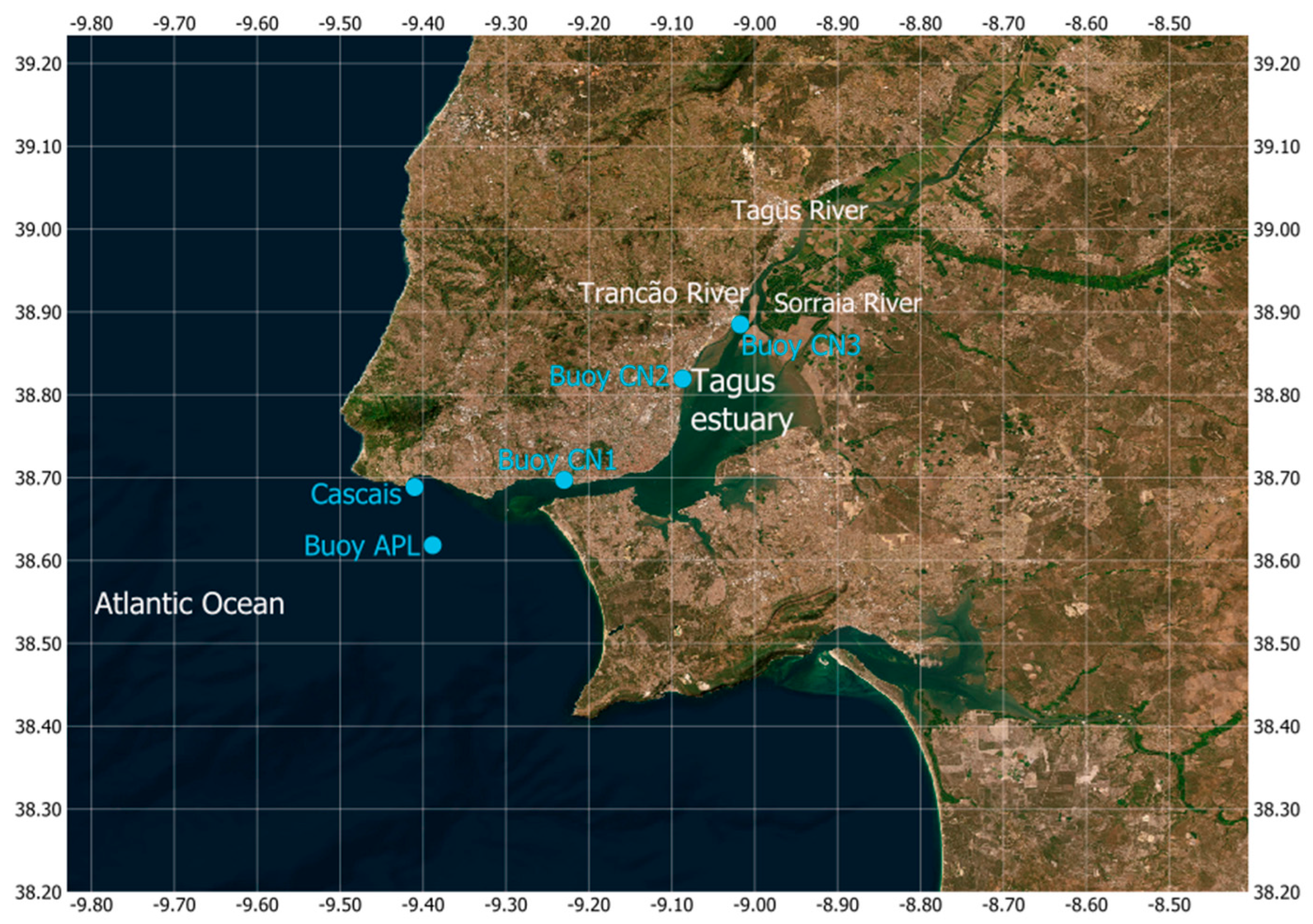
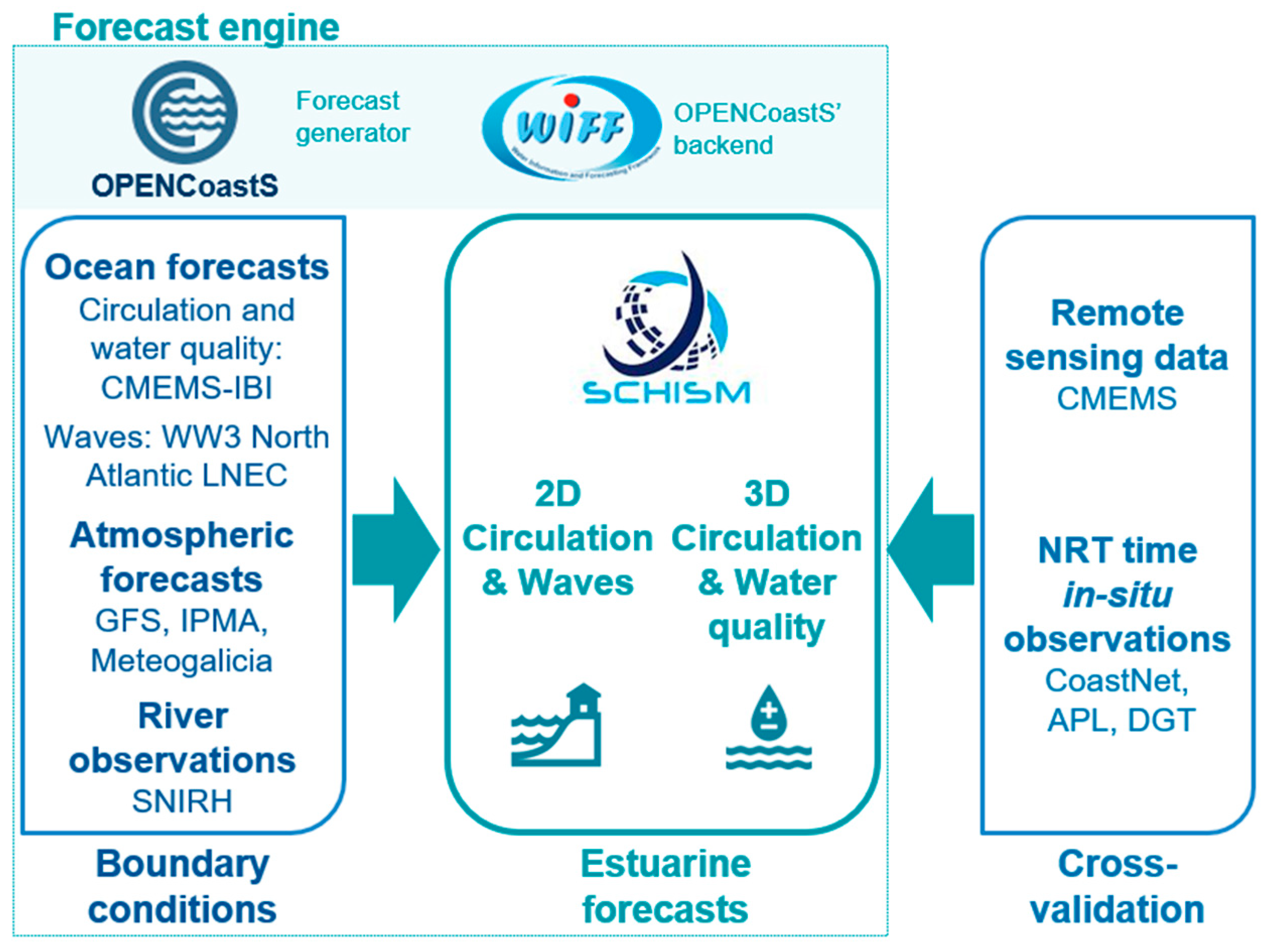

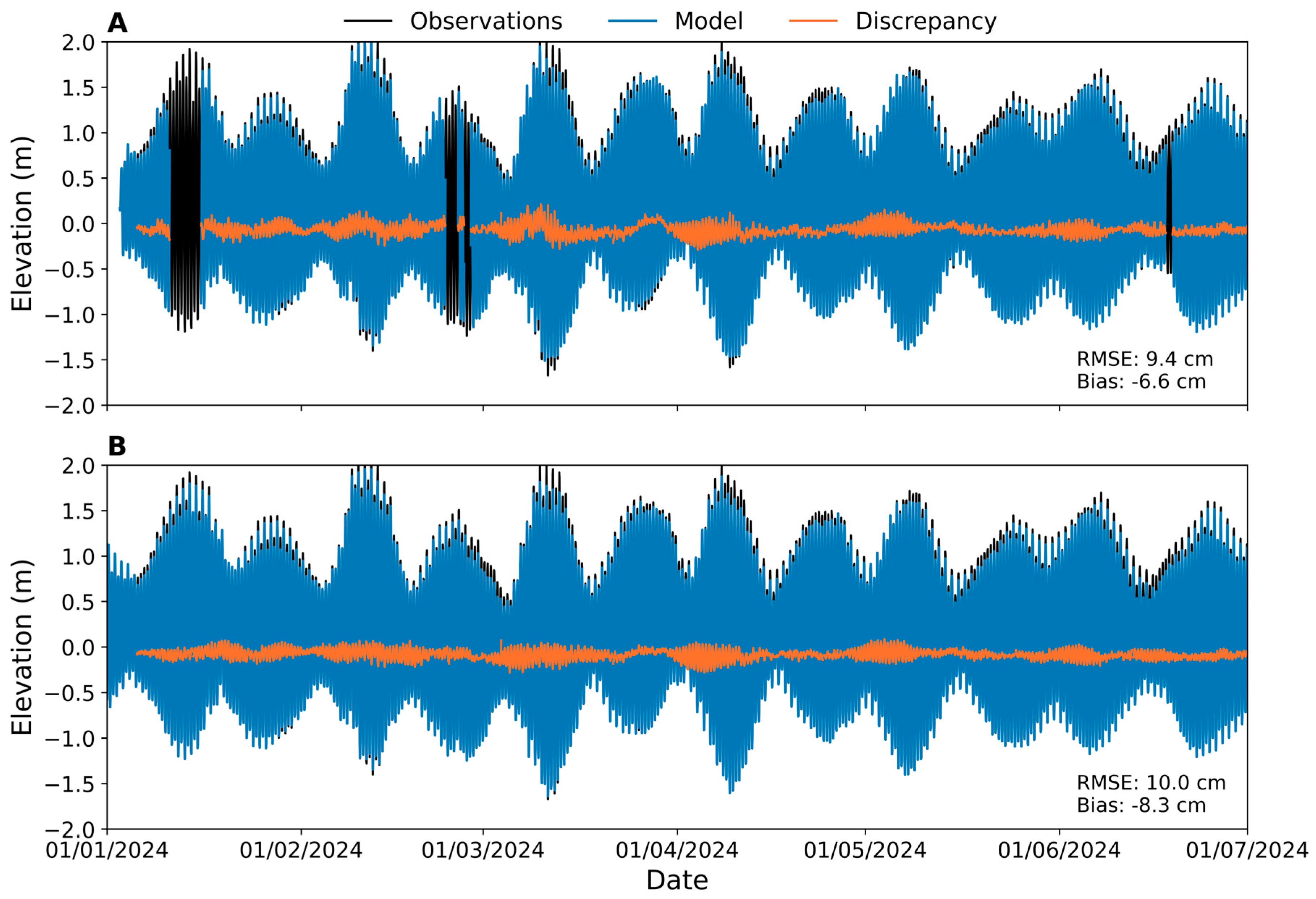

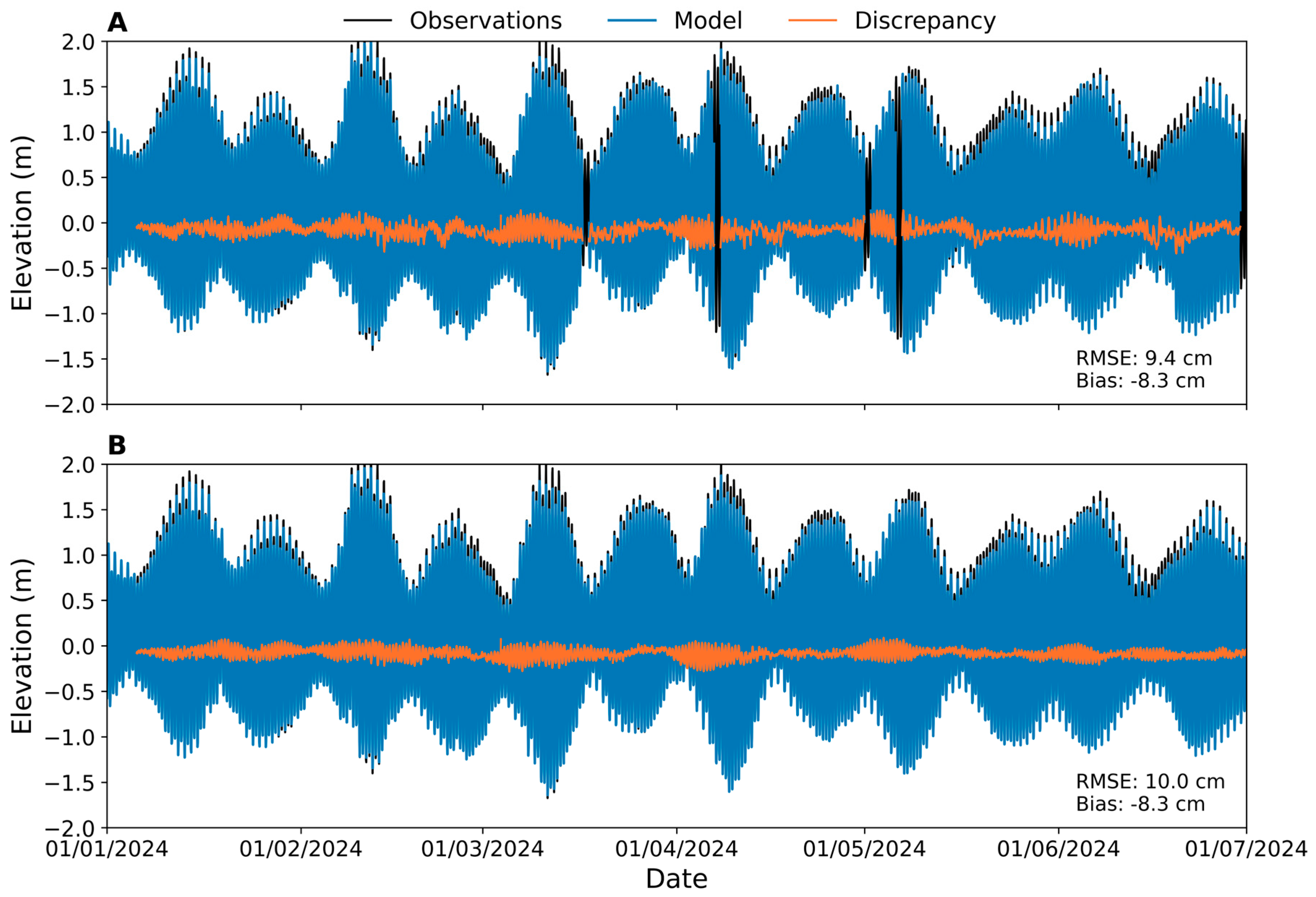
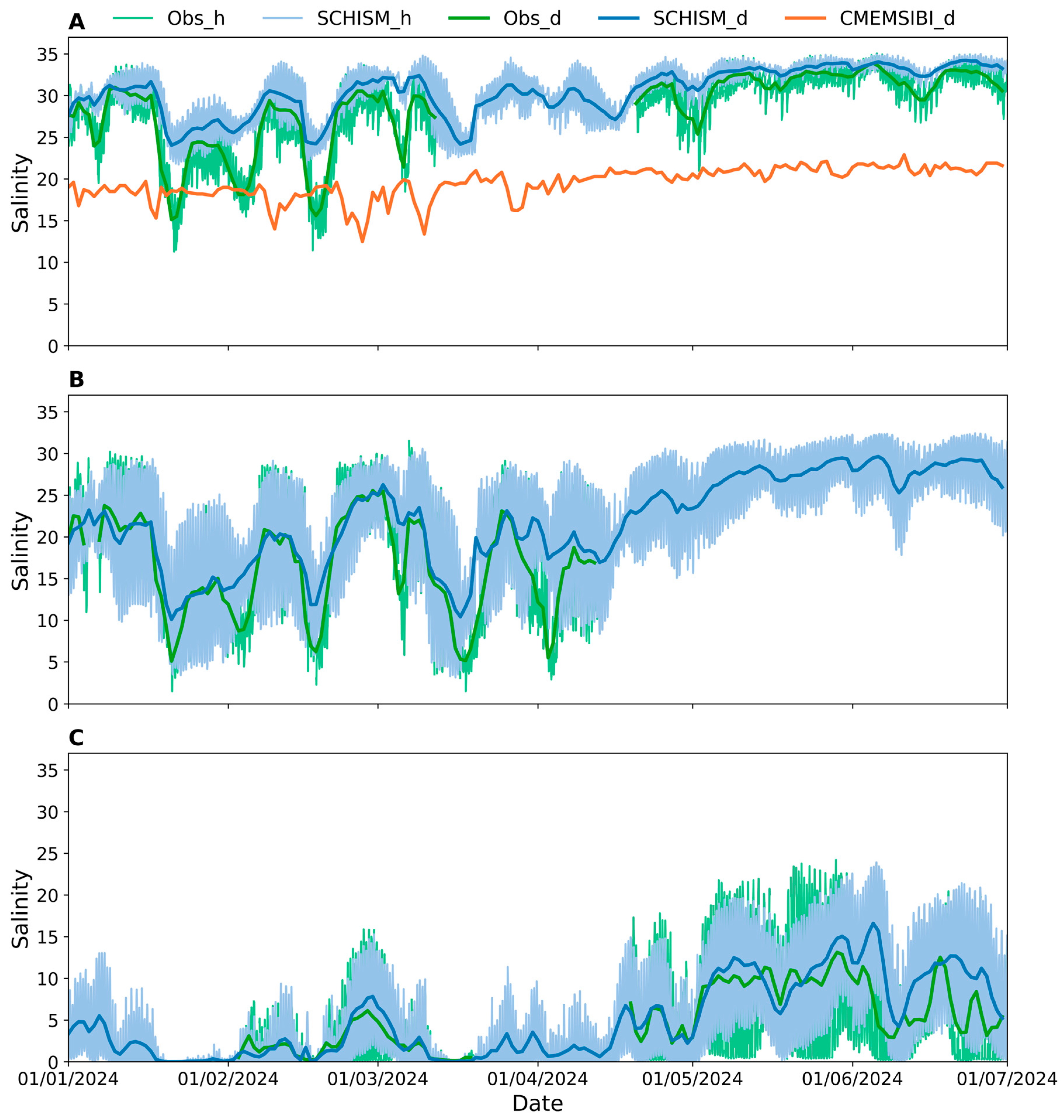
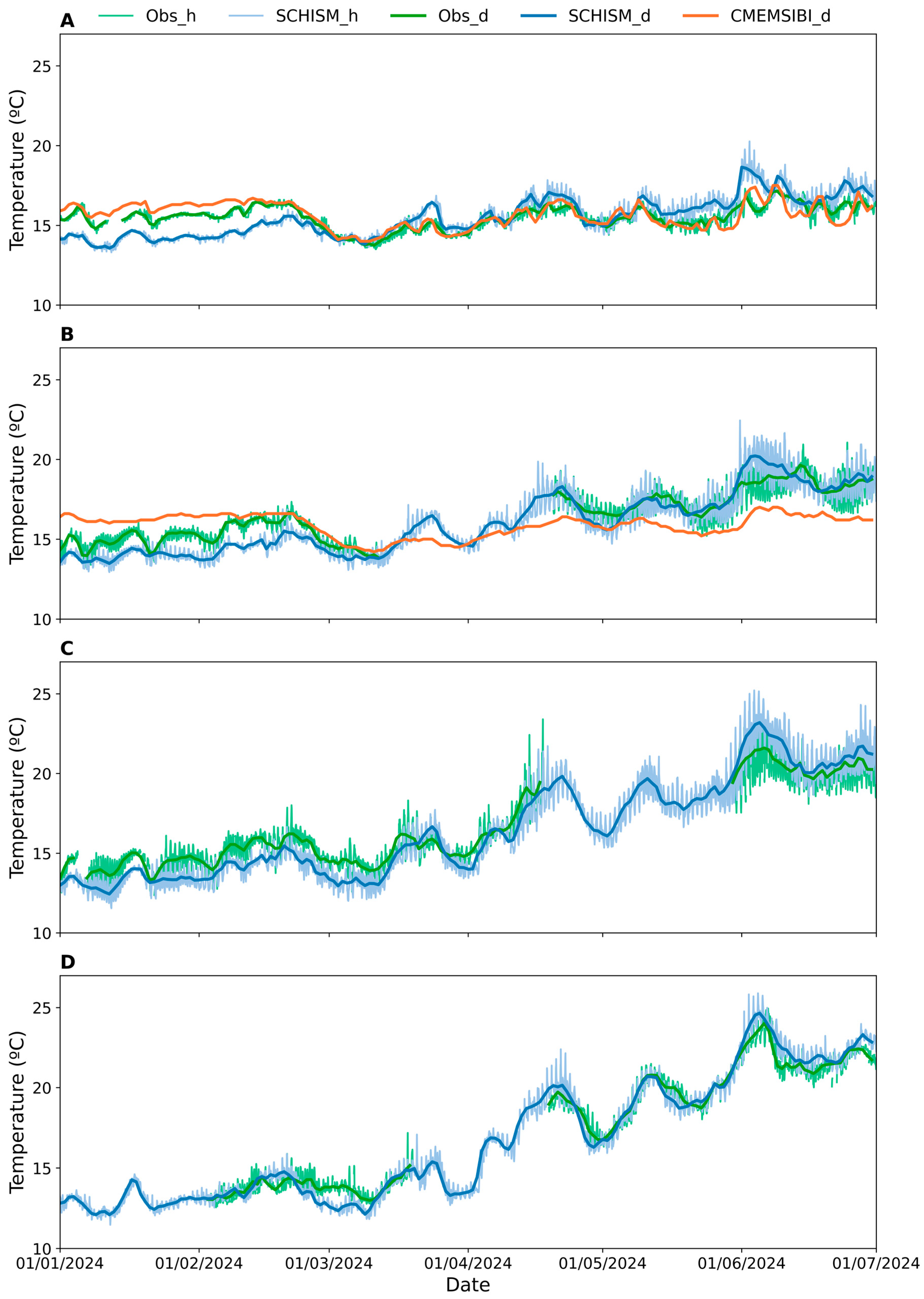
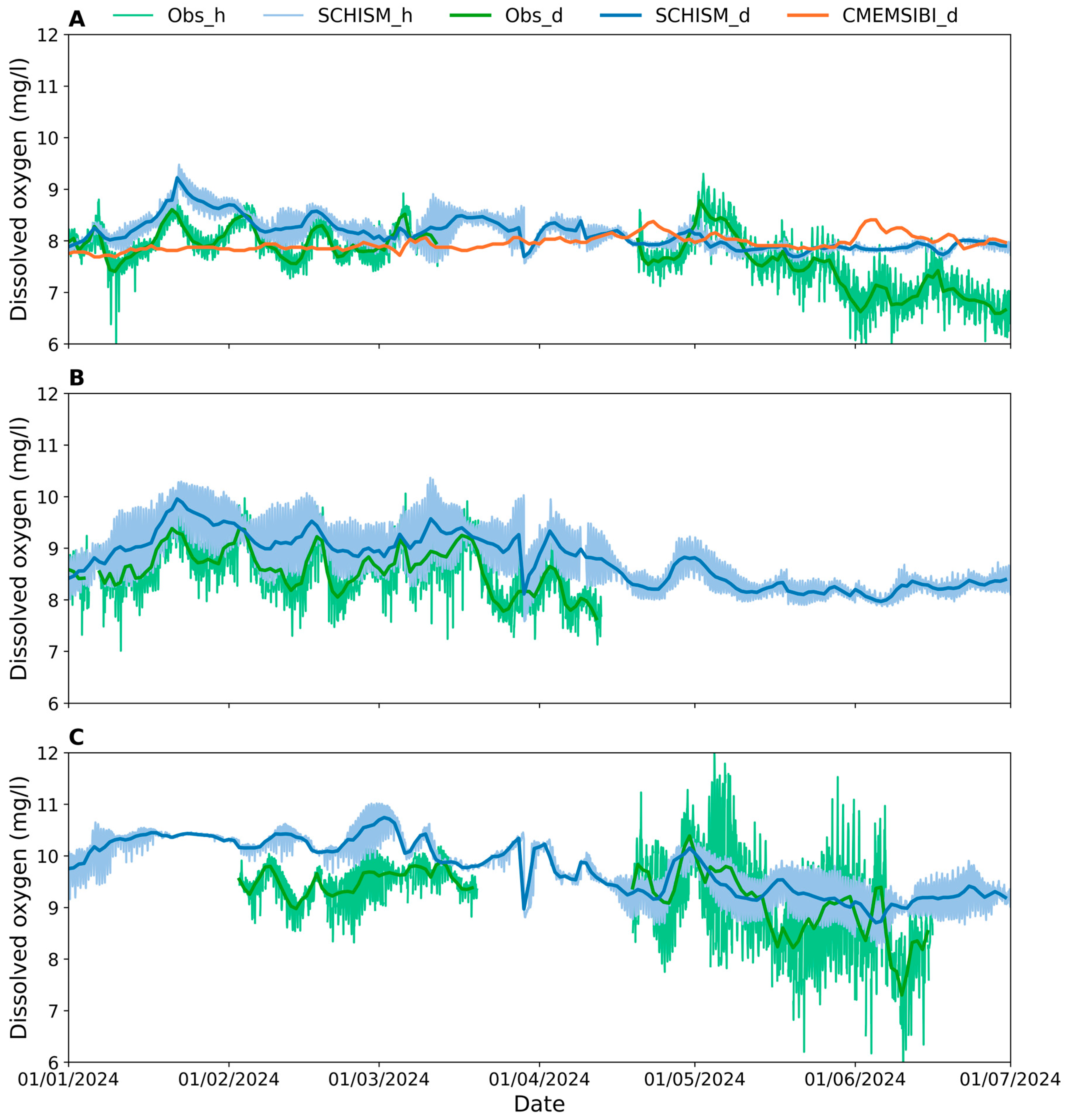
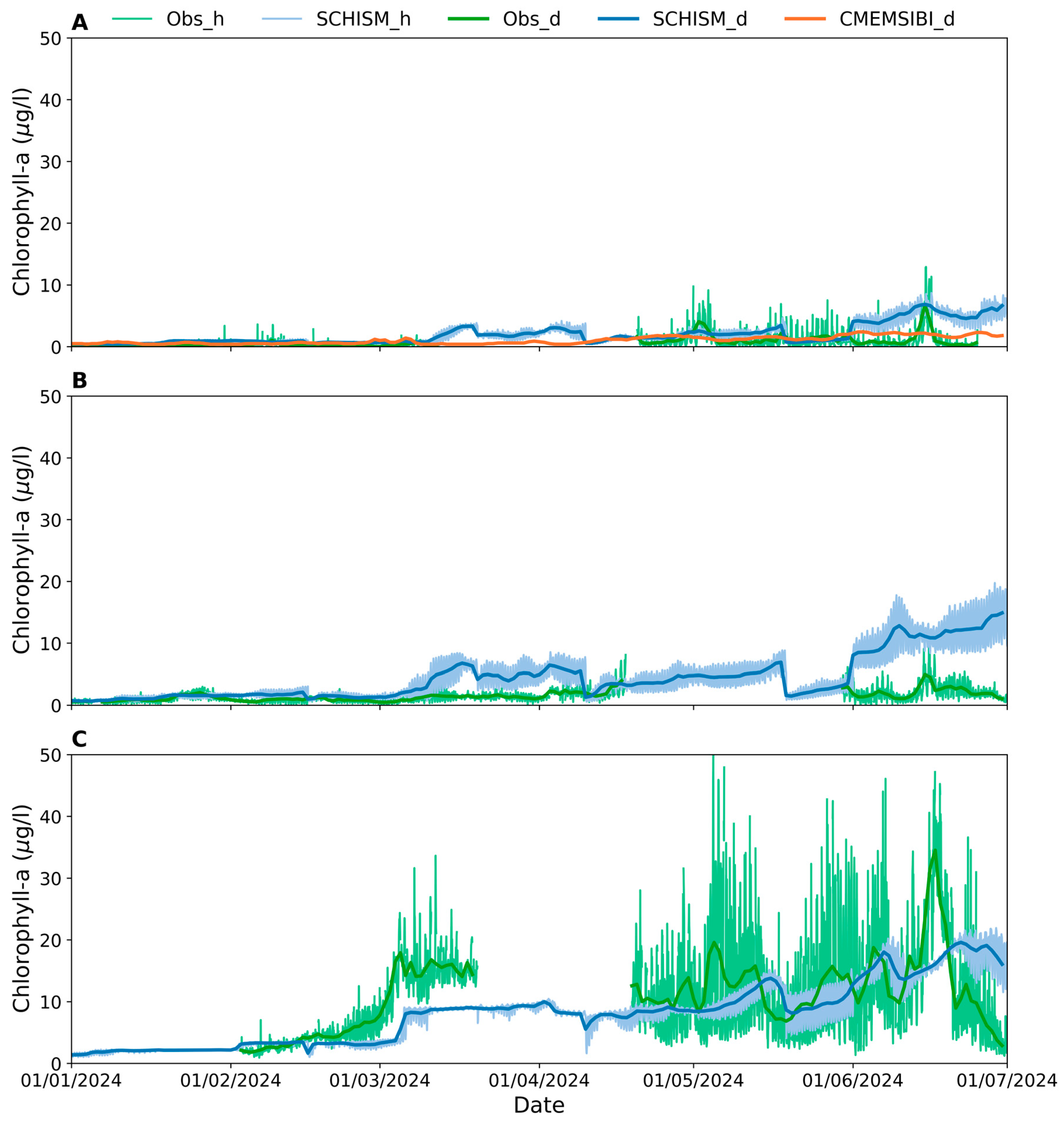
| Cascais | Buoy CN1 | Buoy CN2 | Buoy CN3 | ||||||||||
|---|---|---|---|---|---|---|---|---|---|---|---|---|---|
| RMSE | MAE | R | RMSE | MAE | R | RMSE | MAE | R | RMSE | MAE | R | ||
| SCHISM 3D | |||||||||||||
| Temperature (°C) | Daily mean | 0.9 | 0.8 | 0.60 | 0.9 | 0.7 | 0.96 | 1.0 | 0.9 | 0.98 | 0.6 | 0.5 | 0.99 |
| Hourly values | 1.0 | 0.8 | 0.58 | 0.9 | 0.8 | 0.91 | 1.1 | 0.9 | 0.97 | 0.7 | 0.5 | 0.98 | |
| Salinity | Daily mean | - | - | - | 3.2 | 2.4 | 0.93 | 3.8 | 2.6 | 0.83 | 2.8 | 1.8 | 0.84 |
| Hourly values | - | - | - | 3.4 | 2.5 | 0.94 | 4.6 | 3.3 | 0.82 | 3.5 | 2.3 | 0.85 | |
| CMEMS-IBI | |||||||||||||
| Temperature (°C) | Daily mean | 0.5 | 0.4 | 0.80 | 1.5 | 1.3 | 0.39 | - | - | - | - | - | - |
| Salinity | Daily mean | - | - | - | 10.0 | 9.3 | 0.40 | - | - | - | - | - | - |
| Buoy CN1 | Buoy CN2 | Buoy CN3 | ||||||||
|---|---|---|---|---|---|---|---|---|---|---|
| RMSE | MAE | R | RMSE | MAE | R | RMSE | MAE | R | ||
| SCHISM 3D | ||||||||||
| Dissolved oxygen (mg/L) | Daily mean | 0.6 | 0.5 | 0.57 | 0.6 | 0.5 | 0.66 | 0.7 | 0.6 | 0.57 |
| Chlorophyll-a (µg/L) | Daily mean | 1.8 | 1.2 | 0.46 | 4.8 | 3.2 | 0.54 | 5.8 | 4.4 | 0.48 |
| CMEMS-IBI | ||||||||||
| Dissolved oxygen (mg/L) | Daily mean | 0.6 | 0.5 | 0.41 | - | - | - | - | - | - |
| Chlorophyll-a (µg/L) | Daily mean | 0.9 | 0.7 | 0.47 | - | - | - | - | - | - |
Disclaimer/Publisher’s Note: The statements, opinions and data contained in all publications are solely those of the individual author(s) and contributor(s) and not of MDPI and/or the editor(s). MDPI and/or the editor(s) disclaim responsibility for any injury to people or property resulting from any ideas, methods, instructions or products referred to in the content. |
© 2025 by the authors. Licensee MDPI, Basel, Switzerland. This article is an open access article distributed under the terms and conditions of the Creative Commons Attribution (CC BY) license (https://creativecommons.org/licenses/by/4.0/).
Share and Cite
Rodrigues, M.; Fortunato, A.B.; Jesus, G.; Martins, R.J.; Oliveira, A. Operational Inundation and Water Quality Forecasting in Transitional Waters: Lessons from the Tagus Estuary, Portugal. J. Mar. Sci. Eng. 2025, 13, 1668. https://doi.org/10.3390/jmse13091668
Rodrigues M, Fortunato AB, Jesus G, Martins RJ, Oliveira A. Operational Inundation and Water Quality Forecasting in Transitional Waters: Lessons from the Tagus Estuary, Portugal. Journal of Marine Science and Engineering. 2025; 13(9):1668. https://doi.org/10.3390/jmse13091668
Chicago/Turabian StyleRodrigues, Marta, André B. Fortunato, Gonçalo Jesus, Ricardo J. Martins, and Anabela Oliveira. 2025. "Operational Inundation and Water Quality Forecasting in Transitional Waters: Lessons from the Tagus Estuary, Portugal" Journal of Marine Science and Engineering 13, no. 9: 1668. https://doi.org/10.3390/jmse13091668
APA StyleRodrigues, M., Fortunato, A. B., Jesus, G., Martins, R. J., & Oliveira, A. (2025). Operational Inundation and Water Quality Forecasting in Transitional Waters: Lessons from the Tagus Estuary, Portugal. Journal of Marine Science and Engineering, 13(9), 1668. https://doi.org/10.3390/jmse13091668








